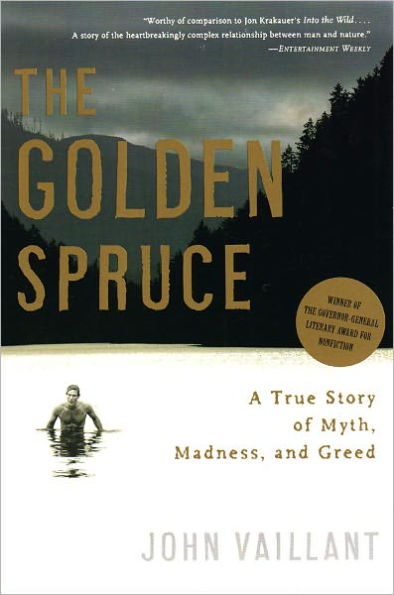The Golden Spruce: A True Story of Myth, Madness, and Greed
A tale of obsession so fierce that a man kills the thing he loves most: the only giant golden spruce on earth.
1102001077
The Golden Spruce: A True Story of Myth, Madness, and Greed
A tale of obsession so fierce that a man kills the thing he loves most: the only giant golden spruce on earth.
16.95
Out Of Stock
5
1

The Golden Spruce: A True Story of Myth, Madness, and Greed
288
The Golden Spruce: A True Story of Myth, Madness, and Greed
288Related collections and offers
16.95
Out Of Stock

Product Details
| ISBN-13: | 9780393328646 |
|---|---|
| Publisher: | Norton, W. W. & Company, Inc. |
| Publication date: | 05/17/2006 |
| Pages: | 288 |
| Product dimensions: | 5.50(w) x 8.30(h) x 0.90(d) |
About the Author
From the B&N Reads Blog
Customer Reviews
Explore More Items
Relive the sensuality, the romance, and the drama of Fifty Shades Freed—the love story that enthralled millions of readers around the world—through the thoughts, reflections, and dreams of
THE OFFICIAL MOVIE TIE-IN EDITION. The major motion picture releases on February 10 in time Valentine's Day 2018 and is based on volume three of the phenomenal #1 New York Times bestselling trilogy
E L James revisits the world of Fifty Shades with a deeper and darker take on the love story that has enthralled millions of readers around the globe.
Their scorching, sensual affair ended in
Now available as a three-volume paperback boxed set, E L James’s New York Times #1 bestselling trilogy has been hailed by Entertainment Weekly as being “in a class by itself.”
T.H. White's masterful retelling of the saga of King Arthur is a fantasy classic as legendary as Excalibur and Camelot, and a poignant story of adventure, romance, and magic that has enchanted
If a serpent swallows the spittle of a fasting man, it dies. Trees felled in the wrong season breed termites. If eels are drowned in wine, those who drink it get a loathing for liquor.
These and
These and
Story of two boys, Kay and Wart, who are learning the code of being a gentleman. Wart later becomes England's King Arthur.
The whole world knows and loves this book. It is the magical epic of King Arthur and his shining Camelot; of Merlin and Owl and Guinevere; of beasts who talk and men who fly, of wizardry and war. It
In his breakout bestseller, The Perfect Storm, Sebastian Junger created "a wild ride that brilliantly captures the awesome power of the raging sea and the often futile attempts of humans to withstand
August 1997
In October 1991 the first of a brutally ferocious series of nor'easters hit the coast of New England. Sebastian Junger, high-climber for tree-removal companies, was writing a book about
In October 1991 the first of a brutally ferocious series of nor'easters hit the coast of New England. Sebastian Junger, high-climber for tree-removal companies, was writing a book about
A profound rumination on the concept of freedom from the New York Times bestselling author of Tribe.
Throughout history, humans have been driven by the quest for two cherished ideals: community
Throughout history, humans have been driven by the quest for two cherished ideals: community
EL LIBRO EN QUE SE BASE LA SERIE LIMITADA DE NETFLIX -- producida y dirigida por Shawn Levy (Stranger Things), protagonizada por Mark Ruffalo, Hugh Laurie y la nueva incorporación Aria Mia
*NOW A NETFLIX LIMITED SERIES—from producer and director Shawn Levy (Stranger Things) starring Mark Ruffalo, Hugh Laurie, and newcomer Aria Mia Loberti*
Winner of the Pulitzer Prize and
Winner of the Pulitzer Prize and
From the Pulitzer Prize–winning author of All the Light We Cannot See, perhaps the most bestselling and beloved literary fiction of our time, comes a triumph of imagination and compassion, a
